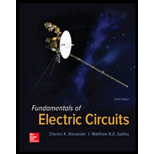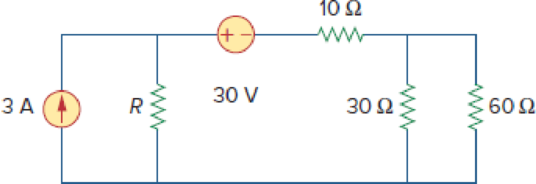
Concept explainers
Consider the 30-Ω resistor in Fig. 4.134. First compute the Thevenin equivalent circuit as seen by the 30-Ω resistor. Compute the value of R that results in Thevenin equivalent resistance equal to the 30-Ω resistance and then calculate power delivered to the 30-Ω resistor. Now let R = 0 Ω, 110 Ω, and ∞, calculate the power delivered to the 30-Ω resistor in each case. What can you say about the value of R that will result in the maximum power that can be delivered to the 30-Ω resistor?
Figure 4.134

Find the Thevenin equivalent seen by the
Calculate the power delivered to the
Answer to Problem 68P
The Thevenin voltage is
The power delivered to the
Explanation of Solution
Given data:
Refer to Figure 4.134 in the textbook.
The current source is
The voltage source is
The Thevenin resistance
Calculation:
In the given circuit, find the Thevenin voltage by removing the 30 ohms resistor and the modified circuit is shown in Figure 1.
The modified circuit is shown in Figure 1.

In Figure 1, the current source with parallel resistance is converted into voltage source with series resistance using source transformation. The voltage V is calculated by using ohms law as follows,
The source transformation is shown in Figure 2.

In Figure 2, the Thevenin voltage is,
Refer to Figure 4.134 in the textbook.
In the given circuit, find the Thevenin resistance by turning off the
The modified circuit is shown in Figure 3.

In Figure 3, the Thevenin resistance is,
Substitute
Substitute 50 for R in equation (1) to find the Thevenin voltage in volts.
Substitute 50 for R in equation (2) to find the Thevenin resistance in ohms.
The Thevenin equivalent connected to the 30 ohms resistor is shown in Figure 4.

The power delivered to the 30 ohms resistor is,
Substitute 60 for
Consider the resistance
When
Substitute 0 for R in equation (2) to find the Thevenin resistance in ohms.
When
Substitute 0 for R in equation (1) to find the Thevenin voltage in volts.
When
Substitute
Consider the resistance
When
Substitute 110 for R in equation (2) to find the Thevenin resistance in ohms.
When
Substitute 110 for R in equation (1) to find the Thevenin voltage in volts.
When
Substitute
Consider the resistance
When
Simplify equation (2) as follows,
Substitute
When
Simplify equation (1) as follows,
Substitute
When
Substitute
Thus, when
Conclusion:
Thus, the Thevenin voltage is
The power delivered to the
Want to see more full solutions like this?
Chapter 4 Solutions
Fundamentals of Electric Circuits
- Using the superstition theorem, how would I prove the second images problem, given that #2 (voltage source was replaced with a short) measured 5 amps, and #4 (had the current source replaced with an open circuit) measured 1.6 amps?arrow_forward#7. Use Nodal analysis, Mesh Analysis, and Superposition to solve following problem: Determine v, in the circuit of Fig. 4.80]arrow_forward4.57 Obtain the Thevenin and Norton equivalent circuitsat terminals a-b for the circuit in Fig. 4.123.arrow_forward
- Problem 4.9 a.) Find the Norton equivalent circuit of Fig. 4.8 external to the resistor R. b) Convert the Norton equivalent to Thevenin equivalent using source transformation. c) Compare the results with part (b) to your answer in Problem 4.8 (a)arrow_forwardGiven the circuit in Fig. 4.117, obtain the Norton equivalent as viewed from terminals:arrow_forwardFind the Thevenin equivalent circuit of the circuit in Fig. 4.34 to the left of the terminals.arrow_forward
- Use superposition to find v0 in the circuit of Fig.4.77.arrow_forwardNumber 4.29 Use source transformation to find correctly Vo in the circuit of Fig. 4.97.arrow_forwardApply Norton/Thevenin theorem to the circuit below to find Norton equivalent of the circuit. Calculate the voltage V0 and the current I0. What is the power that is absorbed by R2arrow_forward
- derive the simplified Norton Equivalent circuit. should be in terms of only the resistors, constants, Vx & IY. No other analysis method besides equivalent circuits and source transformations can be used.arrow_forwardCalculate the Thevenin equivalent circuit seen through the terminals (a, b) & draw the equivalent mThevenin equivalent.arrow_forward"SUPERPOSITION THEOREM" Please Find the Vo Using SUPERPOSITION THEOREM thankyou very much! I've included a cicruit app to check if your answer was correct and close to the value of currents and voltages which is 0.5V thankyou! I've been testing simple circuits to practice problems using different theorems,I appreciate you very much Thankyou!arrow_forward
 Introductory Circuit Analysis (13th Edition)Electrical EngineeringISBN:9780133923605Author:Robert L. BoylestadPublisher:PEARSON
Introductory Circuit Analysis (13th Edition)Electrical EngineeringISBN:9780133923605Author:Robert L. BoylestadPublisher:PEARSON Delmar's Standard Textbook Of ElectricityElectrical EngineeringISBN:9781337900348Author:Stephen L. HermanPublisher:Cengage Learning
Delmar's Standard Textbook Of ElectricityElectrical EngineeringISBN:9781337900348Author:Stephen L. HermanPublisher:Cengage Learning Programmable Logic ControllersElectrical EngineeringISBN:9780073373843Author:Frank D. PetruzellaPublisher:McGraw-Hill Education
Programmable Logic ControllersElectrical EngineeringISBN:9780073373843Author:Frank D. PetruzellaPublisher:McGraw-Hill Education Fundamentals of Electric CircuitsElectrical EngineeringISBN:9780078028229Author:Charles K Alexander, Matthew SadikuPublisher:McGraw-Hill Education
Fundamentals of Electric CircuitsElectrical EngineeringISBN:9780078028229Author:Charles K Alexander, Matthew SadikuPublisher:McGraw-Hill Education Electric Circuits. (11th Edition)Electrical EngineeringISBN:9780134746968Author:James W. Nilsson, Susan RiedelPublisher:PEARSON
Electric Circuits. (11th Edition)Electrical EngineeringISBN:9780134746968Author:James W. Nilsson, Susan RiedelPublisher:PEARSON Engineering ElectromagneticsElectrical EngineeringISBN:9780078028151Author:Hayt, William H. (william Hart), Jr, BUCK, John A.Publisher:Mcgraw-hill Education,
Engineering ElectromagneticsElectrical EngineeringISBN:9780078028151Author:Hayt, William H. (william Hart), Jr, BUCK, John A.Publisher:Mcgraw-hill Education,





